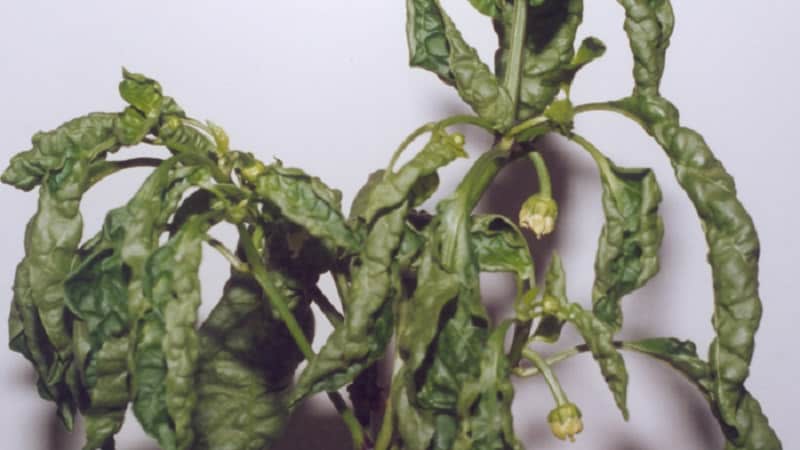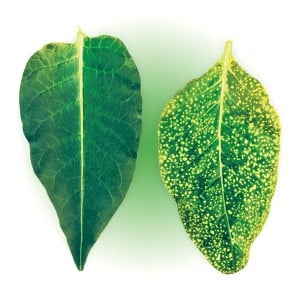How and with what to combat diseases of pepper seedlings
Pepper seedlings are prepared 3 months before planting in the ground. The seedling method protects the crop from sudden weather changes and improves seed germination. However, even if all planting rules are followed, seedlings can develop a viral, fungal or bacterial disease. Let's take a closer look at the diseases of pepper seedlings and their treatment.
Causes of diseases of pepper seedlings
One of the main causes of diseases is contaminated seeds.. To prevent the development of the disease, disinfection is carried out using a solution of potassium permanganate or Bordeaux mixture. Disinfection destroys dangerous microbes on the surface of seeds and strengthens the immunity of the future plant.

Diseases also occur due to poor quality soil.. There should be no weeds, larvae, or debris in the ground. Before planting seedlings, the soil is disinfected and cleaned of grass residues. For disinfection, use heating in the oven or placing in the freezer for a day.
Proper care also plays an important role.. If the watering and fertilizing regime is not followed, the risk of getting sick increases. Other reasons include an excess of minerals, lack of sunlight and heat. It is important to water and fertilize the seedlings on time. If the seeds are sown in small containers, then 15 days from the moment of planting the plant is transplanted into a larger container - they are planted.
Important! Attention is paid to processing the container for seedlings. The container is thoroughly washed with warm water and wiped dry with a clean towel.If seedlings are planted in milk or kefir boxes, then additionally wipe them with a weak solution of manganese.
Types of diseases and methods of combating them
All sweet pepper diseases are divided into three groups: fungal, viral and bacterial. We will analyze each category in detail and identify the causes of infection.
Fungal diseases
Fungal diseases actively develop due to high humidityTherefore, it is important to follow the watering regime and moisten the seedling at the root, bypassing the stems and leaves.
Blackleg
 Causes of the disease - thickened plantings, waterlogging, lack of heat. For prevention, seeds and soil are disinfected, and varieties resistant to fungal diseases are selected.
Causes of the disease - thickened plantings, waterlogging, lack of heat. For prevention, seeds and soil are disinfected, and varieties resistant to fungal diseases are selected.
The fungus lives in the upper layers of the soil, however, upon touching the roots it penetrates into the plant. The roots become dark brown and the stem becomes weak. If a fungus is detected, the affected seedlings are removed, and the remaining sprouts are treated with HOM or Bordeaux mixture.
Gray rot
Signs of gray rot - brown spots and gray plaque at the base of the stem. Fungus appears due to stuffiness, cold water, and cramped containers. For prevention, spraying bushes with copper sulfate is used.
If the pepper is already sick, the infected seedlings are removed, and the healthy ones are transplanted into a new container and treated with the drug “Fitosporin”.
Fusarium
Fusarium wilt appears due to sudden temperature changes, lack of mineral and organic components in the soil - nitrogen, calcium, potassium, phosphorus. The plant withers and drops its leaves, which occurs due to blockage of blood vessels.
It is impossible to cure infected seedlings; they are eliminated. The remaining sprouts are treated with Maxim and sprayed with a whey-based solution.
Good to know:
Step-by-step instructions for growing pepper seedlings
Why do you need to pincher peppers and how to do it correctly
Late blight
One of the most common fungal diseases. Appears due to contaminated soil, watering with cold tap water, and temperature changes.

Late blight is recognized by brown and brown spots. If the symptoms of infection are not detected in time, the plant withers and dries out.
Used for prevention:
- spraying with nettle solution;
- treatment with dry wood ash;
- treatment with Previkur or Oksikhom.
In case of infection, the seedlings cannot be saved - they are removed, and the remaining plants are transplanted into a clean, disinfected container.
Bacterial diseases
The causative agents of the disease are bacteria that live in soil, water, and insect larvae. It is not easy to identify a bacterial disease of seedlings - you need to know the characteristics of the symptoms.
Black bacterial spot
Small black dots appear on the stem and leaves, which become larger over time. Bacteria spread throughout the plant, disrupting the metabolism in the body. For prevention, peppers are sprayed with a soap solution or Bordeaux mixture. The affected seedlings are destroyed.
Important! Hardening helps to avoid black bacterial spotting. The seedlings are taken out onto the balcony or street every day for 2-3 hours, or the seedlings are placed in the freezer. Hardening strengthens the immunity of seedlings and prepares them for planting in the garden.
Fulminant bacterial wilt
Bacteria in conditions of high humidity penetrate into the vessels of the plant and release toxins. Soon the bushes wither and the leaves dry out. For prevention, seeds are disinfected in a solution of succinic acid.
In case of infection, the affected bushes are removed from the container, and the remaining seedlings are picked and sprayed with Previkur.

Soft bacterial rot
Wet rot appears in the form of a weak stem and dark spots on the leaves and stem. Bacteria disrupt the functioning of blood vessels, and the bushes slowly wither. It is recommended to regularly ventilate the room, but avoid drafts. Spraying with a solution of milk and iodine will help to avoid rot. Infected seedlings cannot be treated.
Read also:
Bacterial cancer of pepper
The development of bacterial cancer is promoted by a hot climate, dense planting, and excessive watering.. Small dots appear on the leaves, which eventually spread throughout the bush. If detected, seedlings are sprayed with mustard solution or treated with a solution based on burdock leaves. Affected seedlings are removed from the container.

Viral diseases
Viruses live in plant debris, soil, and weeds. Therefore, it is important to disinfect the soil and clean it before planting. The danger of the virus is that it first penetrates the plant cells and only then begins to develop. It is impossible to destroy the virus; the only way to save the crop is to eliminate the affected bushes.
Tobacco mosaic
 The tobacco mosaic virus appears as a yellow-green pattern on the leaves. Blackening of the leaf blade and falling off are also observed. Favorable conditions for development are low light and high humidity.Infection occurs through seeds, water, and soil.
The tobacco mosaic virus appears as a yellow-green pattern on the leaves. Blackening of the leaf blade and falling off are also observed. Favorable conditions for development are low light and high humidity.Infection occurs through seeds, water, and soil.
If action is not taken, These seedlings produce deformed peppers with a bitter taste. For prevention, watering with a solution of manganese and spraying with whey are used.
Stolbur
The virus lives in weeds, plant debris, soil. When damaged, the leaves turn yellow and dry out, and the bush stops growing. For prevention, carefully loosen the soil with a fork so that the soil becomes light and airy.
Spraying with Barrier or Oksikhom will help protect peppers from stolbur.
Prevention measures for pepper diseases
Used for prevention folk remedies, professional garden preparations, pharmaceutical drugs.
Recognized as the most effective:
 A solution based on laundry soap: 1 liter of water requires 20 g of dry grated soap.
A solution based on laundry soap: 1 liter of water requires 20 g of dry grated soap.- Spraying with boric and succinic acid, Bordeaux mixture, copper sulfate.
- Treatment with a solution of red hot pepper: 150 g of dry pods are required for 2 liters of water.
- Application of mineral and organic fertilizers: manure, litter, potassium superphosphate, ammonium nitrate.
- The use of mineral organic fertilizers - “Zdraven”, “Magic Leika”.
- Spraying with the preparations “Fitosporin”, “Previkur”, “Maxim”, “Oxychom”.
- Adding growth stimulator "Kornevin".
- Germination and hardening of seeds before planting.
- Spraying with a solution of iodine and milk: 15 drops of iodine and 300 ml of milk are required for 1 liter of water.
Important! When spraying bushes, the spray bottle must be clean. The distance between the spray bottle and the plant is at least 50 cm. When using complex mineral fertilizers or professional products, follow the dosage and manufacturer’s recommendations.It is not recommended to treat one disease with several drugs at the same time.
Conclusion
Bell pepper seedlings need timely watering and fertilizing. If the growing rules are not followed, diseases of the leaves and stems appear. These can be either viral diseases, for example, stolbur or tobacco mosaic, or fungi - fusarium or late blight.
The bacterial group includes black spot or soft rot. To prevent diseases, the seeds are thoroughly disinfected. They are planted only in a clean container and disinfected soil. Spraying with manganese or whey helps to avoid diseases.